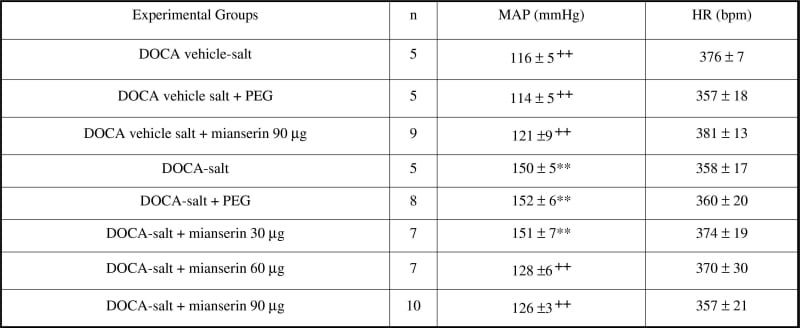Central 5-HT2 receptors have been implicated in the control of blood volume through the activation of a central angiotensinergic pathway to release of vasopressin (see Ramage, 2001). Vasopressin is essential for the development of DOCA-salt hypertension (Crofton et al. 1979). Experiments were carried out to determine if blockade of 5-HT2 receptors with mianserin (Bonhaus et al. 1995) would prevent the development of DOCA-salt hypertension in rats. Fifty six male Wistar rats (150-200g) under recovery anaesthesia with choral hydrate (400 mg kg-1, i.p.) had i.c.v. guide cannulas inserted (see Anderson et al. 1992) and were uninephrectomized. Five days later, DOCA (15 mg kg-1, s.c.) or vehicle (soybean oil, 0.25 ml) and mianserin (30, 60 or 90 μg per rat, i.c.v.) or 3μl of vehicle (10% PEG) were given twice daily for 20 days. Rats were provided with water containing 1% NaCl and 0.03% KCl. One day before and during the experimental period, daily water intake and urinary sodium content and volume were determined (Bissoli et al. 2000). On the 21st day a catheter was placed into the femoral artery, under recovery anaesthesia with ether, from which MAP and HR were measured 6 h later. At the end of the experiments, the rats were humanely killed. The MAP and HR changes in these above groups are shown in Table 1. Mianserin, 90 or 60 μg for 20 days prevented the development of hypertension in rats receiving DOCA-salt but did not affect blood pressure in rats on salt alone. The dose of 30 μg had no effect on the development of the hypertension nor did the vehicle. Mianserin 90 μg also prevented the increase in fluid intake, urinary flow and sodium excretion caused by DOCA-salt treatment. In DOCA-salt rats receiving vehicle, urinary flow was 14 ± 4 ml and sodium excretion was 24 ± 7 mEq kg-1 on day 0; however, by day 20 both values had significantly (P <0.05) increased to 49 ± 17 ml and 44 ± 6 mEq kg-1, whereas in the mianserin group they were not significantly different; at day 0 urinary flow was 16 ± 3 ml and sodium excretion was 18 ± 2 mEq kg-1, while on day 20 they were 21 ± 5 ml and 26 ± 4 mEq kg-1, respectively. In DOCA-salt rats fluid intake on day 0 was similar to that on day 20, being 75 ± 20 ml and 81 ± 10 ml, respectively. However, for the mianserin-treated rats it was reduced from 68 ± 13 ml to 47 ± 7 ml by day 20, which was significantly different from that of DOCA-salt rats. These data indicate that this action of mianserin is not due to an intrinsic hypotensive action but an action which involves interference with the mechanism by which DOCA salt treatment causes hypertension. The data overall support the view that to induce hypertension with DOCA-salt, central 5-HT2 receptors need to be activated to cause the release of vasopressin which has been shown to be responsible for the initiation of DOCA-salt treatment hypertension.
University of Bristol (2005) J Physiol 567P, PC33
Poster Communications: Chronic treatment with mianserin prevents DOCA-salt hypertension in rats
Silva, Andreia L; Cabral, Antiono M; Abreu, Glaucia R; Jose, Pires G; Bissoli, Nazare S; Ramage, Andrew G;
1. Pharmaology, University College London, London, United Kingdom. 2. Departmento de Ciencias Fisiologicas, Unversidade Federal do Espirito Santo, Victoria, Brazil.
View other abstracts by:
Table 1. Effects of chronic i.c.v. injections (for 20 days) of mianserin on MAP and heart rate (mean ± S.E.M.) in control and DOCA-salt hypertensive rats. **P∠0.01 when compared to DOCA vehicle-salt + PEG. ++P∠0.01 when compared to DOCA-salt + PEG group using repeated measures ANOVAs for the main effects and Fisher test for paired comparisons between the means
Where applicable, experiments conform with Society ethical requirements.

